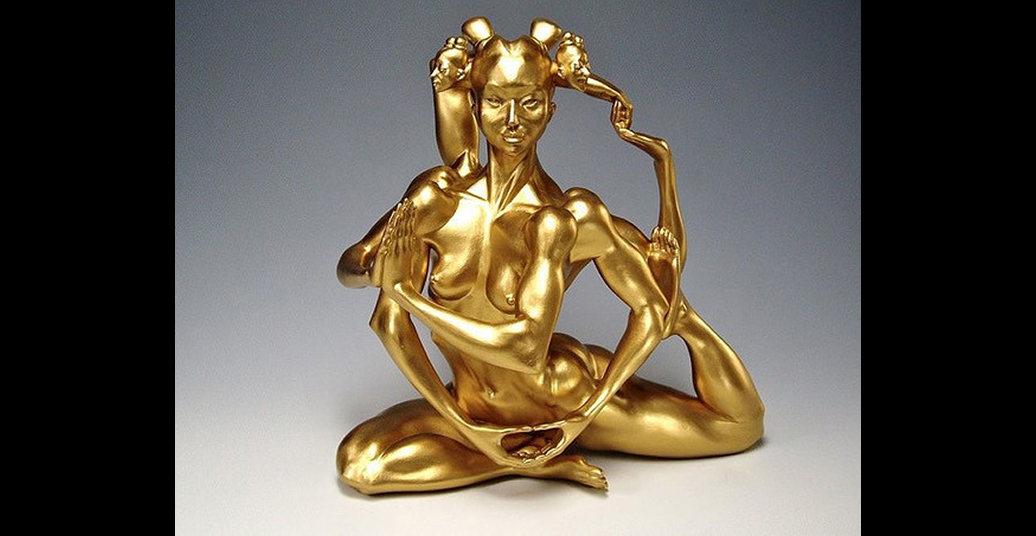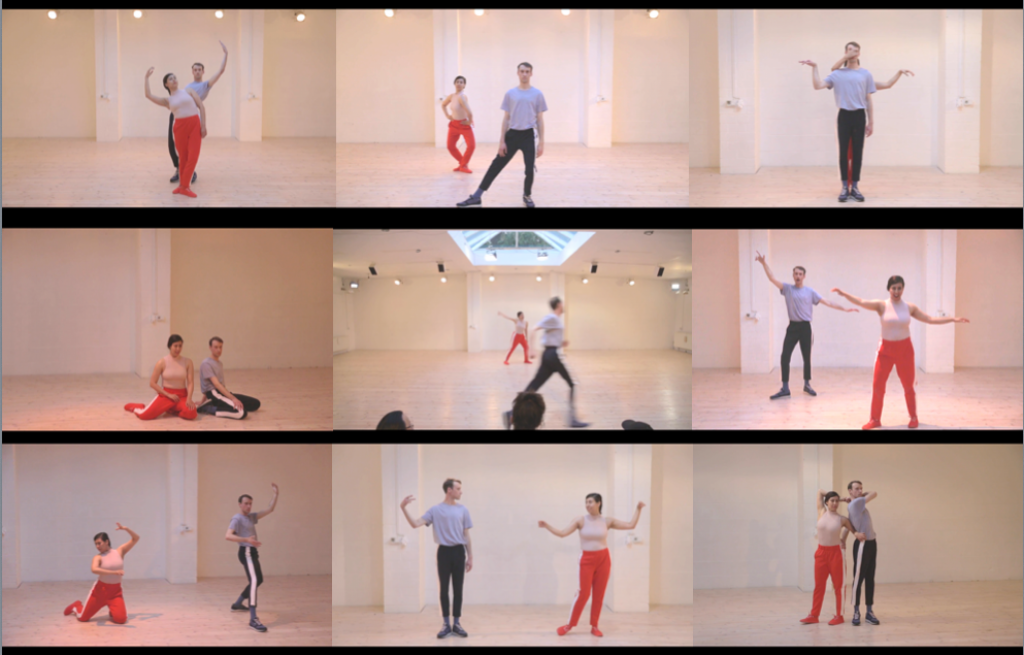“Sarabande” by Sasha Amaya, and “Tricks for Gold (T4$)” by Frida Giulia Franceschini premiered at the Sophiensæle on 8 January in the frame of Tanztage Berlin 2020.
During the long intermission between “Sarabande” and “Tricks for Gold (T4$),” I sit outside the theatre in the lounge, sandwiched between two pretty people. They caress each other and speak, draping their bodies nonchalantly over me. I feel as though I am a piece of furniture that they can lean on. I enjoy this furniture moment that hints at ‘Berlin-cool’: They are not shy at all to touch. In fact, they indulge in it, holding hands affectionately and placing them on my knee as they speak. Their mannerisms and appearance are gender non-binary. They speak openly about their love interests. They are both here to watch the second piece of the evening’s double-bill, “T4$.” The person on my right says: “It should be very good. It’s sexy, funny and queer.” The one on my left affirms, “Check, check, check!”
A quick online search has informed me that the Sarabande of the first piece of the evening ‘is a dance that originated in Central America back in the 16th century.’ The following sentence interests me: ‘At first, it was regarded as being rather scandalous, even being banned in Spain for its obscenity.’ Measured against the yardstick of Berlin’s freedom of expression in the 21st century, however, baroque dances are obviously an outdated version of social interaction, where one whispers one’s desires in a rather suppressed manner in accordance to the strict rules of the patterns, steps, gestures, and distance.
Although once seen as ‘scandalous’ and ‘obscene,’ the Sarabande that Amaya and her on-stage partner Falk Grever recreate in the contemporary context feels like a heavy transparent lid on a pot of boiling water. One can see and hear the boiling liquid under the lid — and it even cracks open for a split-second here and there from the force of turbulent water beneath — but for the most part, the lid stays teasingly shut. Amaya zooms into the aesthetics and the movement vocabulary of baroque dances, deconstructs them, and then puts them back together according to a personal aesthetic that is an idiosyncratic blend of regal cool; chic yet quirky. These qualities are mostly expressed in a consciously balanced ebb and flow, none ever overpowering the others. Movements are composed intentionally and executed precisely in repetitions and variations, except for a few pops of openings — such as Grever running ‘freely’ around in a circle, and a dramatic, a cappella duo lip-synch.
“Sarabande”, Sasha Amaya ©Nobutaka Shomura, Sasha Amaya
The most captivating elements of this work are the two performers and the dynamic between them. Amaya, a visually female body, is dressed in blue and embodies a grounded and assertive character. Grever, meanwhile, is male-bodied and dressed in yellow, personifying dainty and arguably more feminine traits. Amaya occasionally smiles and seems to be at ease, while Grever has a mysterious, alien-like, and absent expression. The energy between them is not quite erotic, yet neither neutral nor cold. Their two distinctively different presences bring together glimpses of an eccentricity that is undeniably charming.
In contrast to this performance composed of undercurrents, “T4$” is a feast of delicious satisfaction for the feisty Berlin audience who delights in watching the lid fly off and the boiling water erupt out of the pot like a geyser. Franceschini plays a ‘lonely heroine who becomes the object of her own desire and tries to turn herself into money.’ Without any shyness in revealing her muscular and slender figure under her minimal clothing, Franceschini represents a seductive, strong, and confident female figure. The colourful draped fabrics, erotic and beautiful costumes, and exaggerated, consciously queer actions carried out with deadly conviction by Franceschini and her sassy assistant Lea Kieffer create a kitsch aesthetic that is on-point for Berlin’s beloved “DIY, unusual, and sexy” style.
The piece is very entertaining. Franceschini carries out ‘magic tricks’ that betray their secrets, yet are funny due to the theatricality and commitment of their performance. Franceschini pulls out ropes from the sides of the stage and hooks the ends to something under a lump of white fabric on the floor. She exits. Kieffer then pulls each rope and peels each piece of fabric away in a slow and dramatic fashion. The movement underneath the fabric grows, making it clear that there is a dancing human body beneath. More and more layers of fabric are pulled away, but there are just even more of them underneath in different colours. This playful act of suspense creates an intense curiosity, and a fetishisation of the mysterious and the unseen. At the last moment before the final reveal, blinding lights blaze at the audience, then Franceschini pops out from under the last piece of black velvet fabric in a new, hot-red costume. The audience is given a moment to realise that the change-over must have happened during the blaze of light. An explosion of laughter and applause ensues. Franceschini is transformed into the idealised goddess of our erotic desire, and she is proud to be so.
“T4$” embodies the epitome of ‘Berlin-cool’ that praises ‘sexy, fun, and queer.’ The audience seems ready to have a good time, laughing and applauding enthusiastically at every little gesture made by the charismatic Franceschini. In contrast, the audience exuded a relatively quiet and contained air during “Sarabande”. “T4$” feels like one of those exciting Berlin parties that the hip art crowd would be eager to attend. “Sarabande” felt like witnessing, willingly or unwillingly, an agreeable, yet, at times, endearingly awkward personal encounter between two people.





